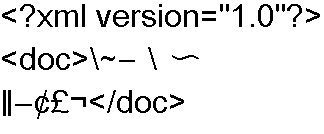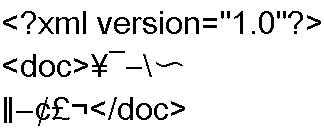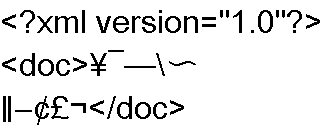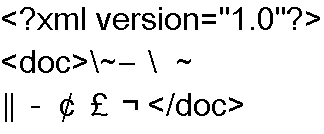Abstract
XML Japanese Profile addresses the issues of using Japanese
characters in XML documents. In particular, ambiguities in
converting existing Japanese charsets to Unicode are clearly
pointed out.
Status of this document
By publishing this document, W3C acknowledges that Panasonic,
Toshiba, Academia Sinica, Alis Technologies, Sun Microsystems have
made a formal submission to W3C for discussion. Publication of this
document by W3C indicates no endorsement of its content by W3C, nor
that W3C has, is, or will be allocating any resources to the issues
addressed by it. This document is not the product of a chartered W3C
group, but is published as potential input to the W3C Process. Publication of
acknowledged Member Submissions at the W3C site is one of the benefits
of W3C Membership. Please
consult the requirements associated with Member Submissions of section
3.3 of the W3C Patent Policy. Please consult the complete list of acknowledged W3C Member
Submissions. See also Submission request and
Team Comment.
A list of current W3C technical documents can be found at the
Technical Reports
page.
Comments on this document should be sent to eb2m-mrt@asahi-net.or.jp
.
XML Japanese Profile [JIS TR X 0015]
was originally published by Japanese Standards Association (JSA) in
the Japanese language. It is not a standard but rather a technical
report, which is intended to encourage public discussion, promote
consensus among relevant parties, and eventually become a Japanese
Industrial Standard (JIS), if appropriate. [JIS TR X 0015] was developed by the XML special
working group (XML SWG) of Information
Technology Research and Standardization Center (INSTAC), JSA
.
This specification is technically identical to [JIS TR X 0015]. The XML SWG intends to keep this
document and [JIS TR X 0015] in sync.
Table of Contents
- 1. Scope
- 2. Normative References
- 3. Definitions
-
- 3.1 Japanese Characters
- 3.2 Coded Character Sets
- 3.3 Character Encoding Schemes
- 3.4 Charsets
- 3.5 XML Constituents
- 4. Coded Character Sets
-
- 4.1 JIS X 0208:1978
- 4.2 Compatibility
Characters
- 5. Character Encoding Schemes
-
- 5.1 UTF-16
- 5.2 UTF-8
- 5.3 Shift-JIS
- 5.4 Japanese EUC (Compressed)
- 5.5 ISO-2022-JP
- 6. Charset Names
-
- 6.1 Charsets for an XML document
containing Japanese characters
- 6.2 Code Conversion during
Transmission
- 6.3 Storing transmitted XML constituents
to files for information interchange
- 7. XML Constituents in Files for
Information Interchange
- 8. Delivering XML Constituents by HTTP
1.1
- 9. Delivering XML Constituents via EMAIL
or NEWS
- 10. Avoiding Conversion
Ambiguities
- 11. The xml:lang Attribute
Appendices
- A Name Characters
(Non-Normative)
- B Needs for Japanese XML profile
(Non-Normative)
- C Ambiguities in conversion from
Shift-JIS to Unicode (Non-Normative)
- D Ambiguities in conversion from
Japanese EUC to Unicode (Non-Normative)
- E Conversion tables for Shift-JIS and
Japanese EUC (Non-Normative)
- F Charset parameters in HTTP1.1
(Non-Normative)
- G Non-normative references
(Non-Normative)
- H Changes from the first edition W3C
Note 14 April 2000 (Non-Normative)
This technical report addresses the issue of Japanese characters
in XML documents thereby complementing [XML].
NOTE: In this technical report, the phrase
"Japanese characters" is used to refer to the graphic characters
specified in [JIS X 0208] and [JIS X 0212] as well as Halfwidth Katakana, the yen
sign, and the overline specified in [JIS X
0201].
For high interoperability of XML documents containing Japanese
characters, this technical report studies character encoding
schemes (CESs) for Japanese characters. CESs for files for
information interchange and CESs for each protocol (SMTP, HTTP/1.1
and others) are specified separately. Furthermore, this technical
report lists conversion tables for converting these CESs to
[ISO/IEC10646 (all parts)] or [Unicode 3.2].
NOTE: Refer to [IETF RFC
2130] for the source definition of the terms "Coded Character
Set" and "Character Encoding Scheme" in this technical
report.
NOTE: This technical report may be ignored if
full interoperability for Japanese XML documents is not
required.
Most parts of this technical report are mere adaptations of IETF
RFCs and W3C recommendations for Japanese characters.
NOTE: For example, [XML]
discourages the use of compatibility characters, defined in Section
3.6 D21 of [Unicode 3.2]. Accordingly, this
technical report discourages the use of Halfwidth Katakana
characters defined in [JIS X 0201], which
are compatibility characters.
When some part of this technical report is adopted from
[XML] and other IETF RFCs or W3C
recommendations, the source reference is indicated in a
subsequent note or appendice.
Any of the following JISs refers to its latest version. If an
RFC is superseded by another RFC, the new RFC is referenced.
- IANA Official Names for Character Sets
- IANA (Internet Assigned Numbers Authority). Official Names
for Character Sets, ed. Keld Simonsen et al. http://www.iana.org/assignments/character-sets
- IETF RFC 1468
- IETF (Internet Engineering Task Force). RFC 1468: Japanese
character encoding for Internet messages, ed. J. Murai, M.
Crispin, and E. van der Poel. 1993.
- IETF RFC 2045
- IETF (Internet Engineering Task Force). RFC 2045:
Multipurpose Internet Mail Extensions (MIME) Part One: Format of
Internet Message Bodies, ed. N. Freed and N. Borenstein.
1996.
- IETF RFC 2046
- IETF (Internet Engineering Task Force). RFC 2046:
Multipurpose Internet Mail Extensions (MIME) Part Two: Media
Types, ed. N. Freed and N. Borenstein. 1996.
- IETF RFC 2130
- IETF (Internet Engineering Task Force). RFC 2130: The Report
of the IAB Character Set Workshop held 29 February - 1 March,
1996, C. Weider, C. Preston, K. Simonsen, H. Alvestrand, R.
Atkinson, M. Crispin, P. Svanberg. 1997.
- IETF RFC 2277
- IETF (Internet Engineering Task Force). RFC 2277: IETF
policy on character sets and languages, ed. H. Alvestrand.
1998.
- IETF RFC 2278
- IETF (Internet Engineering Task Force). RFC 2278: IANA
Charset Registration Procedures, ed. N. Freed and J. Postel.
1998.
- IETF RFC 2279
- IETF (Internet Engineering Task Force). RFC 2279: UTF-8, a
transformation format of ISO 10646, ed. F. Yergeau. 1998.
- IETF RFC 2396
- IETF (Internet Engineering Task Force). RFC 2396: Uniform
Resource Identifiers (URI): Generic Syntax, ed. T. Berners-Lee,
R. Fielding, and L. Masinter. 1998.
- IETF RFC 2616
- IETF (Internet Engineering Task Force). RFC2616: Hypertext
Transfer Protocol --- HTTP/1.1, ed. R. Fielding, J. Gettys, J.
Mogul, H. Frystyk, and T. Berners-Lee. 1999.
- IETF RFC 2781
- IETF (Internet Engineering Task Force). RFC 2781: UTF-16, an
encoding of ISO 10646, ed. P. Hoffman. and F. Yergeau.
2000.
- IETF RFC 3023
- IETF (Internet Engineering Task Force). RFC 3023: XML media
types, ed. M. Murata, S. St.Laurent, and D. Kohn. 2001.
- IETF RFC 3066
- IETF (Internet Engineering Task Force). RFC 3066: Tags for
the Identification of Languages, ed. H. Alvestrand. 2001.
- ISO/IEC 646
- International Organization for Standardization. Information
technology — ISO 7-bit coded character set for information
interchange
- ISO/IEC10646 (all parts)
- International Organization for Standardization. Information
technology — Universal Multiple-Octet Coded Character Set
(UCS)
- JIS TR X 0015
- Japanese Industrial Standards Committee. XML Japanese
Profile
- JIS X 0201
- Japanese Industrial Standards Committee. 7-bit and 8-bit
coded character sets for information interchange
- JIS X 0208
- Japanese Industrial Standards Committee. 7-bit and 8-bit
double byte coded KANJI sets for information interchange
- JIS X 0212
- Japanese Industrial Standards Committee. Code of the
supplementary Japanese graphic character set for information
interchange
- JIS X 0221-1
- Japanese Industrial Standards Committee. Universal
Multiple-Octet Coded Character Set (UCS) -- Part 1: Architecture
and Basic Multilingual Plane
- JIS X 4159
- Japanese Industrial Standards Committee. Extensible Markup
Language (XML) 1.0
- TOG/JVC ucs-conv
- TOG/JVC CDE/Motif Technical WG. Problems and Solutions for
Unicode and User/Vendor Defined Characters, OSF Japanese
Vendors Council (OSF/JVC), http://www.opengroup.or.jp/jvc/cde/ucs-conv-e.html
, 1996.
- Unicode 3.2
- The Unicode Consortium. The Unicode Standard, Version
3.2, defined by: The Unicode Standard, Version 3.0 (Reading,
MA, Addison-Wesley, 2000. ISBN 0-201-61633-5), as amended by the
Unicode Standard Annex #28: Unicode 3.1 (http://www.unicode.org/reports/tr28
).
- UNIX International
- UNIX International. UNIX SYSTEM V Release 4 Nihongo Kankyou
Kyoutuu Kiyaku (Common specifications for the Japanese computing
environement), Toppan, 1992.
- US-ASCII
- American National Standards Institute, Coded character set
— 7-bit American National Standard Code for Information
Interchange, ANSI X3.4-1986.
- XML
- W3C (Worlde Wide Web Consortium). XML (Extensible Markup
Language) 1.0 (Second Edition), W3C Recommendation,
http://www.w3.org/TR/REC-xml
, 1998.
[Definition: ] A
Coded Character Set (CCS) is a mapping from a
set of characters to a set of integers.
NOTE: Note that [JIS X
0208] defines Coded Character Sets as correspondences
between characters and bit combination, which differs from this
definition.
[Definition: ] A
Character Encoding Scheme (CES) is a mapping
from a CCS or several CCSs to a set of octets.
[Definition: ] A
charset is a set of rules for mapping from a
sequence of octets to a sequence of characters.
[Definition:
] In this technical report, the phrase XML
constituents is used to mean document entities, external parsed
entities, external DTD subsets, and external parameter
entities.
NOTE: In the XML terminology, the word "entity"
refers to document entities, internal parsed entities, external
parsed entities, external unparsed entities, external DTD subsets,
internal parameter entities, and external parameter entities. Among
them, internal parsed entities, internal parameter entities, and
external unparsed entities need not specify
CESs.
NOTE: Each XML constituent is usually stored in
a file or distributed as a MIME entity via some
protocol.
The use of [JIS X 0208]:1978 (the first
version of JIS X 0208) is an error; results are undefined.
Those digits, Latin characters, and special characters of
[JIS X 0208] which are also specified by
[JIS X 0201] are deprecated. Likewise,
Halfwidth Katakana of [JIS X 0201] are
deprecated.
This technical report recommends the use of UTF-16 (or UTF-8, as
written in UTF-8).
NOTE: [XML] requires any
XML processor to read entities in UTF-16 (or UTF-8, as described in
UTF-8).
NOTE: The charset name for UTF-16 is
"utf-16".
NOTE: Note that UTF-16 as specified in
[XML] is the charset "utf-16" rather than
the charsets "utf-16le" and "utf-16be", where "utf-16be" is Big
Endian UTF-16 without the BOM and "utf-16le" is Little Endian
UTF-16 without the BOM. These three charsets are registered at
[IANA Official Names for Character
Sets].
This technical report recommends the use of UTF-8 (or UTF-16, as
UTF-16 describes).
NOTE: [XML] requires any
XML processor to read entities in UTF-8.
NOTE: The charset name for UTF-8 is
utf-8.
This technical report and [XML] treat
Shift-JIS, an ordinary Japanese charset, as a CES that represents
Japanese characters and [US-ASCII]
characters in [ISO/IEC10646 (all parts)] or
[Unicode 3.2]. For full interoperability in
the Internet, migration from Shift-JIS to UTF-8/UTF-16 is highly
recommended.
There are four major conversion tables from Shift-JIS to
[ISO/IEC10646 (all parts)] or [Unicode 3.2]. This technical report names them
x-sjis-unicode-0_9, x-sjis-jisx0221-1995, windows-31J, and
x-sjis-jdk1_1_7, respectively. These conversion tables are not
identical to each other.
NOTE: Other conversion tables are also in
use.
X-sjis-unicode-0_9 is published by Unicode Consortium as the
conversion table for Shift-JIS (version 0.9). X-sjis-jisx0221-1995
is a conversion table derived from the conversion table in
[JIS X 0221-1] Appendix 2 (including
Appendix 2.2) for the shift encoding which is specified in
[JIS X 0208] Appendix 1. Windows-31J is
published by Unicode Consortium as the conversion table for
Microsoft CP932. X-sjis-jdk1_1_7 is the conversion table used
for the encoding named SJIS in JDK 1.1.7.
NOTE: Use of Shift-JIS cannot provide
interoperability in information interchange, since any of the
above-mentioned conversion tables or some other conversion tables
might be used.
NOTE: It is generally assumed that Shift-JIS
uses [JIS X 0201] rather than [US-ASCII]. This assumption applies to all of these
conversion tables except for x-sjis-jdk1_1_7. [IETF RFC 2046] deprecates the use of any national
or application-oriented version of [ISO/IEC
646] in Internet mail, except when it is completely identical
to US-ASCII.
NOTE: Although Microsoft CP932 is said to be
based on [JIS X 0201], the conversion table
for Microsoft CP932 maps 0x5C to U+005C (REVERSE
SOLIDUS).
NOTE: Other than Japanese characters, CP932
contains NEC special characters, NEC-selected IBM extended
characters, IBM extension characters, and user-defined
characters.
This technical report and [XML] treat
Japanese EUC (Compressed) [UNIX
International], an ordinary Japanese charset in Japan, as a CES
that represents Japanese characters and [US-ASCII] characters in [ISO/IEC10646 (all parts)] or [Unicode 3.2]. For full interoperability in the
Internet, migration from Japanese EUC (Compressed) to UTF-8/UTF-16
is highly recommended.
There are five major conversion tables from Japanese EUC
(Compressed) to [ISO/IEC10646 (all parts)]
or [Unicode 3.2]. This technical report
names them x-eucjp-unicode-0_9, x-eucjp-jisx0221-1995,
x-eucjp-open-19970715-ms, x-eucjp-open-19970715-0201 and
x-eucjp-open-19970715-ascii, respectively. These conversion tables
are not identical to each other.
X-eucjp-unicode-0_9 is derived from the conversion table
published by Unicode Consortium for conversion from [JIS X 0208] to [ISO/IEC10646
(all parts)] or [Unicode 3.2].
X-eucjp-jisx0221-1995 is derived from the one in Appendix 2
(including Appendix 2.2) of [JIS X 0221-1].
X-eucjp-open-19970715-ms, x-eucjp-open-19970715-0201 and
x-eucjp-open-19970715-ascii are conversion tables defined by OSF
Japanese Vendors Council (OSF/JVC) and they are named eucJP-ms,
eucJP-0201 and eucJP-ascii by Appendix of [TOG/JVC ucs-conv].
NOTE: Use of Japanese EUC cannot provide
interoperability in information interchange, since any of these
conversion tables or some other conversion table might be
used.
NOTE: X-eucjp-open-19970715-ms,
x-eucjp-open-19970715-0201 and x-eucjp-open-19970715-ascii contain
NEC special characters, NEC-selected IBM extended characters, IBM
extension characters, and user-defined
characters.
This technical report and [XML] assume
ISO-2022-JP[IETF RFC 1468], an ordinary
Japanese charset in Japan, as a CES that represents Japanese
characters and [US-ASCII] characters in
[ISO/IEC10646 (all parts)] or [Unicode 3.2]. For full interoperability in the
Internet, migration from ISO-2022-JP to UTF-8/UTF-16 is highly
recommended.
This technical report defines conversion from ISO-2022-JP to
[ISO/IEC10646 (all parts)] or [Unicode 3.2] via Shift-JIS or Japanese EUC; that
is, ISO-2022-JP is first converted to Shift-JIS or Japanese EUC and
then converted by one of the tables shown in Shift-JIS or Japanese EUC
(Compressed). Therefore, for each conversion table from
Japanese EUC or Shift-JIS, one conversion table from ISO-2022-JP is
constructed.
NOTE: ISO-2022-JP is a charset designed for
message transmission such as EMAIL. One can thus safely assume that
information in ISO-2022-JP was temporarilly converted from
Shift-JIS or Japanese EUC for message transmission. Therefore, it
is reasonable to convert ISO-2022-JP to [ISO/IEC10646 (all parts)] or [Unicode 3.2] via Shift-JIS or Japanese
EUC.
NOTE: [IETF RFC 1468]
allows those characters in [US-ASCII],
[JIS X 0201], and[JIS X
0208] only. However, some implementations represent Microsoft
CP932 in ISO-2022-JP by allowing NEC special characters,
NEC-selected IBM extended characters, IBM extension characters, and
user-defined characters. x-iso2022jp-cp932 refers to this variation
of ISO-2022-JP.
After omitting identical conversion tables, five conversion
tables are obtained. This technical report names them
x-iso2022jp-unicode-0_9, x-iso2022jp-jisx0221-1995,
x-iso2022jp-cp932, x-iso2022jp-jdk1_1_7, and
x-iso2022jp-19970715-ascii. These conversion tables are not
identical to each other.
Correspondences between ISO-2022-JP and Shift-JIS or
Japanese EUC
|
Conversion from Shift-JIS or Japanese
EUC |
Conversion from ISO-2022-JP |
| Shift-JIS |
x-sjis-jdk1_1_7 |
x-iso2022jp-jdk1_1_7 |
| x-sjis-unicode-0_9 |
x-iso2022jp-unicode-0_9 |
| x-sjis-jisx0221-1995 |
x-iso2022jp-jisx0221-1995 |
| windows-31J |
x-iso2022jp-cp932 |
| Japanese EUC |
x-eucjp-open-19970715-ms |
x-iso2022jp-cp932 |
| x-eucjp-open-19970715-0201 |
x-iso2022jp-jisx0221-1995 |
| x-eucjp-open-19970715-ascii |
x-iso2022jp-19970715-ascii |
An escape sequence of [IETF RFC 1468] (1B
24 42, 1B 24 4A, 1B 28 42, or 1B 28 4A) is an error if it occurs
before the end of an encoding declaration in an ISO-2022-JP XML
constituent. Results are undefined.
NOTE: [XML] specifies that
an XML processor must report an error and stop normal processing
when it is unable to process the employed CES. Most XML processors
cannot handle occurrences of bit combination 1B before the end of
an encoding declaration. Such an occurrence is defined as an error
(whose results are undefined) rather than a fatal error (which
requires suspension) in order not to void XML processors based on
an existing code conversion library. If it is defined as a fatal
error, such XML processors might become
non-conformant.
NOTE: Use of ISO-2022-JP cannot provide
interoperability in information interchange, since any of these
conversion tables or some other conversion tables might be
used.
The conversion tables shown in Character
Encoding Schemes are assumed to be independent and
non-identical charsets, as listed below:
| Unicode |
utf-16 |
| utf-8 |
| Shift-JIS |
x-sjis-unicode-0_9 |
| x-sjis-jisx0221-1995 |
| windows-31J |
| x-sjis-jdk1_1_7 |
| Japanese EUC (Compressed) |
x-eucjp-unicode-0_9 |
| x-eucjp-jisx0221-1995 |
| x-eucjp-open-19970715-ms |
| x-eucjp-open-19970715-0201 |
| x-eucjp-open-19970715-ascii |
| ISO-2022-JP |
x-iso2022jp-unicode-0_9 |
| x-iso2022jp-jisx0221-1995 |
| x-iso2022jp-cp932 |
| x-iso2022jp-jdk1_1_7 |
|
x-iso2022jp-19970715-ascii |
NOTE: Among these charset names, this technical
report recommends only utf-16 and utf-8.
Charset names can be used to specify charsets by the charset
parameter of media types such as "text/xml" and "application/xml"
or the encoding declaration. Those charsets beginning with "x-" are
intended to be used in this document only; they are not intended to
be specified in encoding declarations or MIME headers.
NOTE: The charset parameter is a parameter whose
value is a charset name. In the following example, the charset name
utf-8 is specified by the charset parameter of the
media type "text/xml".
Content-Type: text/xml; charset=utf-8
|
NOTE: [IETF RFC 3023]
STRONGLY RECOMMENDS appropriate charset names for the charset
parameter of the media type "text/xml" or "application/xml".
[XML] requires them in encoding
declarations.
Charset names are case-insensitive.
NOTE: It remains unclear which of the conversion
tables in this technical report will be used for charsets
Shift_JIS, EUC-JP, and ISO-2022-JP, which are registered at
[IANA Official Names for Character Sets].
However, users may use these charsets provided that they do not
require full interoperability.
In the case the CES is altered during transmission, the charset
indicating the new CES must be specified by the charset parameter
of media types such as "text/xml" and "application/xml". XML
processors correctly recognize the CES even if encoding
declarations are not rewritten.
NOTE: [IETF RFC 3023]
specifies that the charset parameter is authoritative and takes
precedence over the BOM or encoding
declaration.
When WWW clients, EMAIL readers, or NEWS readers save the
transmitted XML constituents as files, charset names should be
specified in encoding declarations or the BOM must be embedded in
the beginning of the file, unless the XML constituents are encoded
in UTF-8. Code conversion can be applied to the XML constituents
before they are stored to files.
To store XML constituents in files for information interchange,
they should be encoded in either UTF-16 or UTF-8.
NOTE: Other charsets such as Shift-JIS or
Japanese EUC (Compressed) may be used when full interoperability
for Japanese XML documents is not required.
In storing XML constituents to files, a BOM or encoding
declaration must announce the CES, unless they are encoded in the
default CES, i.e., UTF-8.
NOTE: 4.3.3 of [XML]
requires a BOM or an encoding declaration.
NOTE: When encoded in UTF-16, encoding
declarations are not required since the BOM announces UTF-16 as the
CES.
Without any external information available for the CES, an XML
processor determines the CES from the BOM or encoding declaration.
This auto-detection of CESs is described in Appendix F of
[XML].
When octet streams representing XML constituents serve as
input/output of application programs, such streams should also
follow the rules for information interchange files.
XML servers should use UTF-16 or UTF-8 in delivering XML
constituents.
NOTE: Other charsets such as ISO-2022-JP,
Shift-JIS or Japanese EUC (Compressed) may be used when full
interoperability for Japanese XML documents is not
required.
XML documents delivered via HTTP 1.1 ([IETF
RFC 2616]) with media types such as "text/xml" or
"application/xml" should have the correct charset parameter. In the
case of "application/xml", the charset parameter may be omitted if
the CES is indicated by the BOM or encoding declaration.
NOTE: [IETF RFC 3023]
STRONGLY RECOMMENDS the use of the charset parameter. The charset
parameter takes precedence over the charset specified by the BOM or
encoding declaration.
NOTE: If an XML document is encoded in US-ASCII
and labelled as "text/xml", the charset parameter may be omitted.
Such an XML document, however, is outside the scope of this
technical report, since it cannot contain any Japanese
characters.
NOTE: In configuring WWW servers, the correct
charset should be attached to each file containing an XML
constituent of the media type "text/xml" or
"appllication/xml".
The client determines the CES from the charset parameter. The
default of the charset parameter for "text/xml" is US-ASCII. When
the charset parameter of the media type "application/xml" is
omitted, the auto-detection procedure for information interchange
files is applied.
To deliver an XML constituent as the EMAIL body, they should be
encoded in UTF-16 or UTF-8.
NOTE: Other charsets such as ISO-2022-JP,
Shift-JIS or Japanese EUC (Compressed) may be used when full
interoperability for Japanese XML documents is not
required.
The charset parameter is STRONGLY RECOMMENDED. If the charset is
UTF-16, media types such as "application/xml" shall be used and
"text/xml" shall not be used.
Apply a content transfer encoding (Base64 etc.), if
required.
NOTE: Details of content transfer encodings are
specified by [IETF RFC
2045].
As an example of ambiguous conversion, consider a "Shift_JIS"
XML document as below:
<?xml version="1.0" encoding="shift_jis"?>
<doc>{1}{2}{3}{4}{5}
{6}{7}{8}{9}{10}</doc>
|
where {1} through {10} are used to represent octets as
below:
- 0x5C(YEN SIGN),
- 0x7E(OVERLINE),
- 0x815C(FULLWIDTH EM DASH),
- 0x815F(REVERSE SOLIDUS),
- 0x8160(WAVE DASH),
- 0x8161(DOUBLEVERTICAL LINE),
- 0x817C(MINUS SIGN),
- 0x8191(CENT SIGN),
- 0x8192(POUND SIGN), and
- 0x81CA(NOT SIGN).
Different conversion tables interpret this document
differently.
Case 1: x-sjis-jdk1_1_7
Case 2: x-sjis-unicode-0_9 (the third character is HORIZONTAL
BAR)
Case 3: x-sjis-jisx0221-1995 (the third character is EM
DASH)
Case 4: windows-31J
We can avoid this ambiguity by using character refererences. For
example, the document after normalization in case 3 can be
explicitly specified as below:
<?xml version="1.0" encoding="shift_jis"?>
<doc>\~―\〜
‖−¢£¬</doc>
|
Alternatively, one can declare and use parsed entities for these
character references. The following document captures all Unicode
characters ambiguously represented by Shift_JIS.
<?xml version="1.0?>
<!DOCTYPE doc [
<!ENTITY revsol "\">
<!ENTITY tilde "~">
<!ENTITY cent "¢">
<!ENTITY pound "£">
<!ENTITY yen "¥">
<!ENTITY not "¬">
<!ENTITY mdash "—">
<!ENTITY horbar "―">
<!ENTITY dvline "‖">
<!ENTITY fparato "∥">
<!ENTITY wdash "〜">
<!ENTITY fminus "-">
<!ENTITY fbsol "\">
<!ENTITY ftilde "~">
<!ENTITY fcent "¢">
<!ENTITY fpoun "£">
<!ENTITY fnot "¬">
<!ENTITY fmacron " ̄">
<!ENTITY fbrvbar "¦">
<!ENTITY fyen "¥">
]>
<doc>&revsol;
˜
¢
£
¥
¬
—
―
&dvline;
&fparato;
&wdash;
&fminus;
&fbsol;
&ftild;
&fcent;
&fpoun;
&fnot;
&fmacron;
&fbrvbar;
&fyen;</doc>
|
Use the xml:lang attribute to indicate the use of the Japanese
language for an XML document in whole or in part.
NOTE: The xml:lang attribute is specified in
[XML].
Specify a language code for Japanese (ja, for
example) as the value of this attribute. Values of this attribute
are case-insensitive.
An XML document containing a Japanese paragraph and an English
paragraph is shown below:
<?xml version="1.0" encoding="utf-8"?>
<document>
<para xml:lang="ja">これは段落です。</para>
<para xml:lang="en">This is a paragraph.</para>
</document>
|



